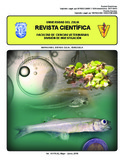Evaluación del uso de plantas y sustratos sintéticos en el desove, viabilidad de huevos y supervivencia de alevines de Chirostoma humboldtianum

Voir/Ouvrir
Date
2018Auteur
Palabras Clave
Pescado blanco, Reproducción, Desove, Sustratos vegetales y sintéticos, CrianzaShortfin silverside fish, Reproduction, Spawning, Plants and synthetic substrates, Breeding
Metadatos
Afficher la notice complèteRésumé
El pescado blanco Chirostoma humboldtianum es un aterínido endémico de México que requiere de estrategias que faciliten su manejo en cautiverio y aumente la producción, debido su importancia socioeconómica y demanda comercial. Por lo cual, se comparó la selección de C. humboldtianum en diferentes sustratos de origen vegetal y sintético en el desove, viabilidad de huevos y supervivencia de alevines en esta especie. El estudio se realizó en estanques circulares de 3 m Ø a cielo provistos de sustratos vegetales y sintéticos para el desove Ceratophyllum demersum, Eichhornia crassipes y Cassuarina equisetifolia; además de fibras de nailon, Agave spp y polietileno. La proporción de huevos y viabilidad de huevos y alevines en cada repetición por sustrato fue registrada. La selección de sustratos en el desove fue significativa E. crassipes y C. equisetifolia (P<0,5), seguida de las fibras de nailon. Los valores de viabilidad de huevos y alevinesfueron superiores en E. crassipes, C. equisetifolia y fibras de nailon (P<0,5). El uso alternativo de sustratos en la reproducción, desove y crianza de C. humboldtianum en cautiverio es factible, así como el reemplazo de vegetación acuática por sustratos sintéticos se desempeñan adecuadamente en el anidamiento y manejo de esta especie de interés comercial.
Colecciones
Información Adicional
| Otros Títulos | Evaluation of the use of plant and synthetic substrates in spawning, egg viability and survival of fingerlings of Chirostoma humboldtianum |
| Correo Electrónico | gavaz@correo.xoc.uam.mx revistafcv@gmail.com |
| Editor | Saber-ULA |
| ISSN | 0798-2259 |
| ISSN Electrónico | 2477-944X |
| Resumen en otro Idioma | Shortfin silverside Chirostoma is an endemic fish of Mexico, a member of the Family Atherinidae that requires strategies to facilitate its management in captivity and to increase its production, due to its economic importance and commercial demand. Therefore the selection of C. humboldtianum on different substrates of plant and synthetic origin in spawning, egg viability and survival of fingerlings of this species was compared. The study was conducted in circular ponds 3 m Ø pit provided with plants including Ceratophyllum demersum, Eichhornia crassipes and Cassuarina equisetifolia, and synthetic substrates such as nylon fibers, Agave spp and polyethylene fibers for spawning. The proportion of eggs and the viability of eggs and fingerlings on each repetition substrate was recorded. The results showed that the selection of spawning substrates was significant in E. crassipes and C. equisetifolia (P <0.05), followed by the nylon fibers. With respect to the values of viability eggs and fingerlings were higher in E. crassipes, C. equisetifolia, and nylon fibers (P <0.05). The alternative use of substrates in the reproduction, spawning and rearing of C. humboldtianum in captivity is possible, and aquatic vegetation could replace with synthetic substrates that are adequate and that perform the nesting and management of this species of commercial interest. |
| Colación | 173-179 |
| País | Venezuela |
| Institución | Universidad del Zulia (LUZ) Universidad de Los Andes (ULA) |
| Publicación Electrónica | Revista Científica |
| Sección | Revista Científica: Artículos |





